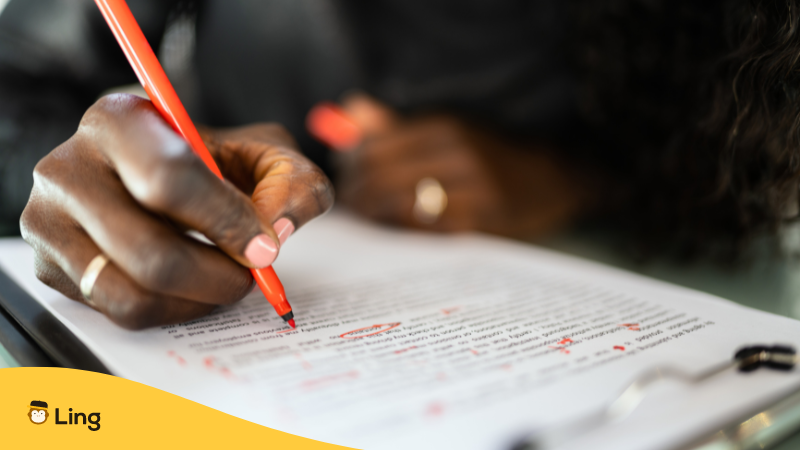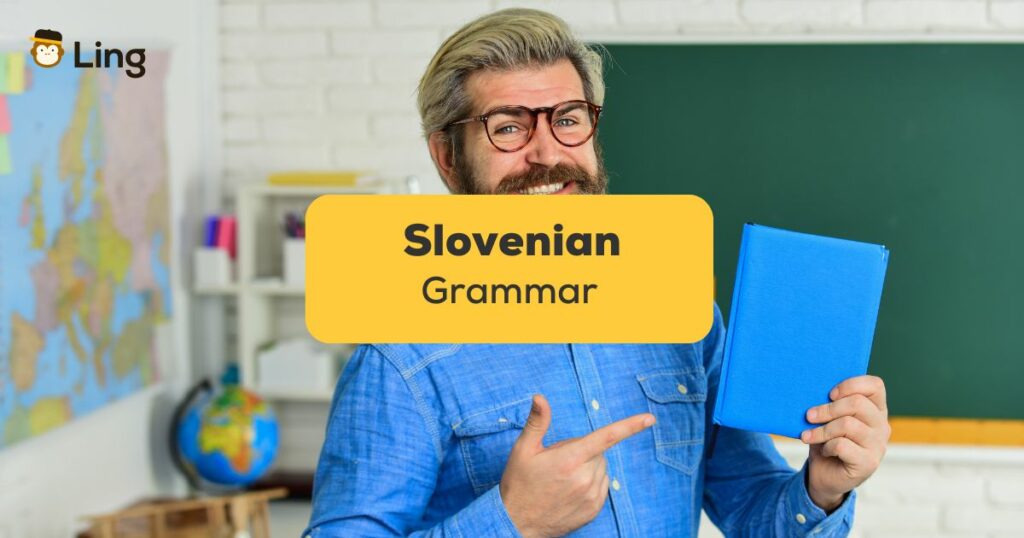Looking to master Slovenian grammar? Great choice! Understanding the rules of grammar in any language is kind of like unlocking the secret code to that language, and Slovenian is no exception.
In this blog, I’ll take you through some basics, give examples, and help you boost your vocabulary of the Slovenian language.
Table Of Contents
What Is Slovenian Grammar?
Grammar is a set of rules that help us keep our words in line and make our sentences smoother. Slovenian grammar tells us how words are used and put together to form sentences in this language. It includes many rules about the word order, verb forms, and some other special features. Curious what they are? In this post, we’ll go through some of them!
Slovenian Grammar Rules And Features
If you’ve ever picked up a grammar book, you know that they are very useful but can be a lot to take in all at once. That’s why I believe a better approach would be to break it down into manageable chunks and go through each concept slowly. So, here’s a list of basics for those new to Slovenian grammar.
Slovenian Nouns
Slovenian nouns can either be masculine, feminine, or neuter. How do we know which noun is which gender? Usually, nouns have certain endings that help determine their gender:
- Masculine nouns usually end with a consonant, i.e., fant (boy).
- Feminine nouns usually end with an ‘-a’, i.e., mama (mom).
- Neuter nouns usually end with an ‘-o’ or ‘-e,’ i.e., sonce (sun).
Keep in mind that this doesn’t apply to all nouns! As you progress in your language learning, you’ll see that there are plenty of exceptions and nouns must be learned by heart in order to do correct declensions. Good thing that Slovenian doesn’t use articles before nouns, right?

Slovenian Verb Forms And Tenses
Slovenian verbs are a grammar category that requires a lot of time to truly master. I’ll tell you all about the basics of Slovenian verbs and their grammatical rules, to help you get started!
The first thing you need to know is about Slovenian grammatical persons and numbers.
Slovenian has three numbers: singular, dual, and plural. Dual is a special feature not found in many other languages. This means that when you’re talking about two people, you’ll use pronouns and verb forms meant only for two people (or things).
Slovenian has three “persons” for talking about who’s doing what. First person is for talking about yourself, second person is for talking to someone else, and third person is for talking about someone else who’s not part of the conversation. Easy!
Unlike English, which has twelve tenses, Slovenian has only three tenses: past, future, and present tense.
The present tense, or sedanjik, describes what is currently or usually happening. For example:
| English | Slovenian |
|---|---|
| I work / I am working | Jaz delam |
| You sleep / You are sleeping | Ti spiš |
| She dances / She is dancing | Ona pleše |
The future tense, or prihodnjik, describes what will happen in the future. It’s usually formed with the auxiliary verb bo (will). The verb is conjugated according to the subject in the sentence and is followed by a future participle of verb.
| English | Slovenian |
|---|---|
| I will work | Jaz bom delala |
| You will sleep | Ti boš spal |
| She will dance | Ona bo plesala |
The past tense, or preteklik, describes things that have happened in the past. It’s used with the auxiliary verb biti (to be). The verb is conjugated according to the subject in the sentence and is followed by a past participle of verb.
| English | Slovenian |
|---|---|
| I was working/worked | Jaz sem delala |
| You were sleeping/slept | Ti si spal |
| She was dancing/danced | Ona je plesala |
Word Order In Slovenian Sentences
How to arrange words in a Slovenian sentence? The basic word order would be the SVO (Subject, Verb, Object), meaning the sentence begins with a subject, is followed by a verb, and ends with an object. For example: jaz imam knjigo (I have a book).
When it comes to more complex sentences, Slovenian allows some flexibility in the sentence structure. But if you understand the basic SVO structure, you already have a solid foundation for learning word order in Slovenian sentences!

The Slovenian Case System
A part of Slovenian grammar that, in my opinion, needs a more detailed explanation is its case system, as it’s a bit harder to understand. While most other Slavic languages know this system, I’ve come across English speakers who have no idea what we are talking about when we mention cases.
So, what is a case system? A case system in language is a way of showing the role of nouns and pronouns in a sentence by changing their endings. This helps us to see whether a noun is the subject, object, etc.
There are six cases in Slovenian, and each one has a different job of presenting what is happening, what is being done to someone or something, where something is, or how something is done.
To better understand this, here’s a table to see how the word miza (table) changes its ending according to cases and what questions are asked when a different case is required:
| Case | Explanation | Questions Asked | Word Declension |
|---|---|---|---|
| Nominative | Subject of the sentence | What is it? Who is it? | Miza |
| Genitive | Possession or relationship | Whose? What type? | Mize |
| Dative | Indirect object | To whom? To what? | Mizi |
| Accusative | Direct object | What? Whom? | Mizo |
| Locative | Location or place | Where? | Mizi |
| Instrumental | Shows the means of doing | With what? By what means? | Mizo |
How Do You Say Grammar In Slovenian?
The word grammar in Slovenian is slovnica. A more rarely used word that is also correct would be gramatika. While the word slovnica, is the standard word describing rules that we have to follow while forming texts and sentences, this word is also used for a book where a system like that is described (i.e., Slovenska slovnica is what a Slovenian grammar book is called).
Slovenian Grammar Vocabulary
Want to know more about the Slovenian language? Here’s some essential vocabulary for when you’re trying to master the grammar:
| English | Slovenian |
|---|---|
| Noun | Samostalnik |
| Verb | Glagol |
| Pronoun | Zaimek |
| Word | Beseda |
| Sentence | Stavek |
| Comma | Vejica |
| Period | Pika |
| Exclamation point | Klicaj |
| Question mark | Vprašaj |
| Adjective | Pridevnik |
| Adverb | Prislov |
| Conjunction | Veznik |
| Preposition | Predlog |
| Tense | Čas |
| Plural | Množina |
| Singular | Ednina |
| Dual | Dvojina |
Frequently Asked Questions About Slovenian Grammar
How Difficult Is Slovenian To Learn?
Slovenian can be hard to learn for English speakers. Its grammar can seem quite challenging at first, and pronunciation may also be tricky due to some different sounds of the language. It will be easier for people who speak or are learning a Slavic language already. Yet, with some practice and dedication, it’s possible to learn in only a few months. Diving deep into the language by talking and using it in daily life can help you learn faster. It will take time, but if you stick with it, you can be very good at speaking Slovenian.
What Are Common Phrases In Slovenian?
In Slovenian, živjo means ‘hello,’ hvala means ‘thanks,’ prosim means ‘please,’ and kako si? means ‘how are you?’ These are basic phrases that are commonly used in Slovenian chats, so they will help you connect with people who speak the language.
What Language Is Slovenian Closest To?
Slovenian is most like other South Slavic languages, such as Croatian and Serbian. These languages are alike in how they build sentences, the words they use, and how they sound because they came from the same area and have a shared history. However, Slovenian is unique and has features that make it different from other South Slavic languages.

Want To Increase Your Knowledge Of Slovenian?
In this blog, we’ve only brushed upon some of the basic Slovenian grammar rules, you can find more by reading our Slovenian blog.
When you start learning a language, grammar rules are necessary to master and understand it fully. It might take some time to move from beginner to experienced Slovenian speaker, but there are ways that may help you learn the language faster. One of them is the Ling app! It’s a way to make language learning fun through games and quizzes and will help you improve whether you’re a complete beginner or have some previous knowledge.































































